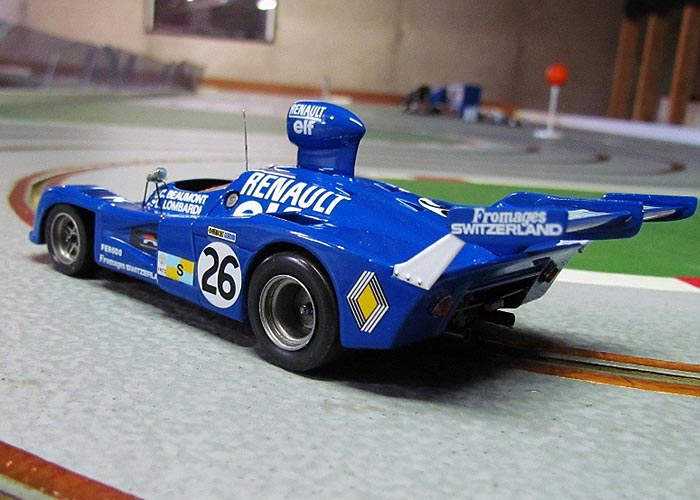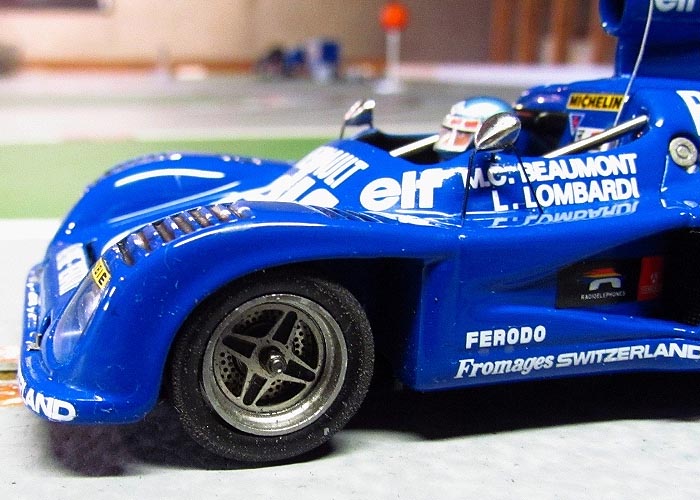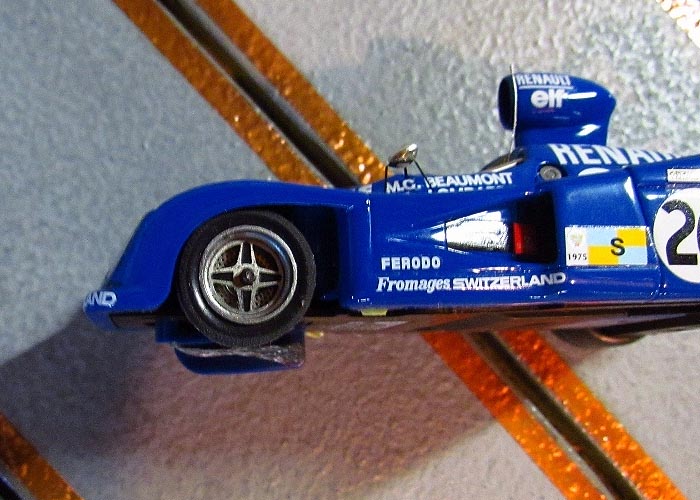
06/26/2012

Le Mans Miniatures Alpine A441: Le Mans, 1975
“Your Grey Poupon, sir…..and your toolkit.”
By Kurt “El Secundo” Moser
In 1974, Alpine dominated the World Sports Car Championship, winning all 9 of 9 races in the 2.0 liter class with the Alpine-Renault A441. The car saw further action in 1975 at Le Mans in the hands of lady drivers Lella Lombardi and Marie-Claude Beaumont. They ran well, but retired 8 hours into the event with a fuel delivery problem. That didn’t stop Le Mans Miniatures from making a spectacular looking version of their car, and that’s what we’ll look at here.
When we say ‘look’, that’s typically all that we do with a car from Le Mans Miniatures. Their reputation of great looking and awful running cars has been earned over the years, so ‘expect the worst, hope for the best, and keep all of your parts suppliers on speed-dial’ may be your best approach. Most folks aren’t excited about the prospect of spending 3 figures for a slot car, and if they do, they want their money’s worth without having to spend more for parts. Well, a word of warning – if your new LMM car is a good runner out of the box, it’s time to buy a lottery ticket, because you might be the luckiest dude on the planet.
Reputation aside, what did we actually get with this release? Well, good news and bad news. The good news is that the bad news isn’t so bad, and that’s really good, if that makes any sense. LMM’s reputation does stay intact, however. On opening the box, the model practically glows with scale goodness. Even if you’ve never heard of the Alpine A441 before, you may find yourself speechless. The bodywork and detail are exquisite, and the car shines like the sun on the deep blue sea. The driver detail is outstanding, and wonderful to see in an open cockpit car. From stem to stern, the car is gorgeous. And when you put it on the track, you may find yourself speechless again, though the reasons may be completely different.



When you open the box, you’ll be greeted with a minor error. The car’s name badge shows that it ran at Le Mans in 1976. It was actually at Le Mans in 1975, but nobody told the guys in the packaging department. Also when you open the box, you’ll notice the red ribbon with the cryptic message “Remove Before Run”. Not knowing what that meant, I promptly removed the red ribbon then went for a jog. Refreshed and just a little tired when I got back, I unscrewed the car from its base (two screws under the cardboard insert) and placed it on the track.

I pulled the trigger, heard a faint ‘rrrrrr…..rrrrr’ from the car, but saw nothing resembling motion. So I tried to turn the wheels, but none of them moved – front or rear. It didn’t take too long to get them turning again, and before I knew it, the car was running some nice laps. This is when I made the mistake of saying “You know, this isn’t such a bad magnet car…”, and as if on cue, the right rear wheel flew off, and the car flipped upside down. Took a while for the laughter to die down!
I’ll spare you some of the gory details, but here’s a list of problems with the car straight out of the box:
1) Rear bushings both out of place
2) Front wheels binding heavily on the chassis
3) Braids about 3 times too thick, and very stiff – more like grill brushes, or battery cables in the Buick
4) Guide way too shallow
5) Heavy interference between chassis and body
6) Broken body post
7) Rough gear mesh
8) Split front tires
9) Rear axle too short
10) Stripped threads on one rear wheel
11) Body detail loose and floating in the car
Now, that sounds like a lot, and it is! Yet somehow, after about an hour of fiddling, testing, and tweaking, the magnet had been pulled, and the car was turning
surprisingly good laps. The list of tweaks wasn’t as big as you might think:

1) Glued rear bushings in place with hot glue
2) Used flat-tip screwdriver to flatten the leading edge of the thick braids
3) Ground the edge of the front wheels to keep them from binding

#3 proved to be the big tweak, and it’s necessary because of bad design. Somebody apparently told LMM that it was a good idea to have holes in their machined wheels, so that you could use short hubs. Sure, great idea – but the holes are too close to the edge of the wheel, so the hole is actually open on one side. This means that the inner rim isn’t smooth, and that gap catches hard on the chassis each time the wheel turns (if it turns at all). I used a Dremel to grind it down a bit, and the transition is much smoother. Not perfect, but definitely better. The other two items were pretty standard, and once these three things were done along with a bit of tire sanding, the car was much, much better than the list of problems would lead you to believe. It was fun to throw around no-mag, and the tires grip nicely on Carrera track. The motor is an unmarked blue can, and is strong enough to haul the heavy resin car around -- punchy, without over-powering the car. There is more potential in this car, and it’s already quicker than many no-mag cars that were on the track that evening.

The ‘mystery du jour’, which we can say because the car is French, is the set of four screws in the midsection on the bottom of the chassis. As a general rule, these screws might loosen a pod, or prevent some bits from detaching from some other bits. A half a turn, and nothing moved, went loose, or fell off. With Le Mans Miniatures car I had no desire to push my luck, so I tightened them back up again and left the mystery for another day. If you want/need to solve this mystery, you can buy one yourself.

Also worth noting is that the interior detail is part of the chassis, and when the body is mated to the chassis, the body binds against the driver, messing with body float. Also, in another WTF moment, it was discovered that the chassis has absolutely nothing to hold the front axle in place. The axle is held to the chassis by the lead wires, and when you put the body on, you get to finagle the axle into the slots molded into the resin body. It’s not that bad, just a little…..weird.

I’d normally expect to replace several parts on a Le Mans Miniatures car, but the only things that seem to need replacing are the split front tires, and possibly the rear wheel with the stripped set screw. Since the tires don’t carry any decals, the scale fans won’t be too upset about changing tires, and Slot.It Zero Grips should do the job up front. No need to change the rear tires, as they feel like Slot.Its, and sand easily. To really help this car, changing the guide to a deeper one and adding thinner braid would be a fantastic idea. I’m not expecting to change the rear wheel, but I’ll glue it in place, most likely. So, for just a few bucks, the biggest issues with this car are easily repaired, and as it runs now, it’s not even necessary to make these changes.

For me, this car is a new favorite. Without any kind of expert tuning tricks, I have a great running car that’s just beautiful. Would I recommend it to a new guy, or someone who doesn’t have much tuning knowledge? Nope, no way. But if you enjoy being amazed by weird design or goofy production mistakes, and don’t mind taking the time or effort to fix them, you’ll be nicely rewarded. It’s like owning an exotic car – temperamental, expensive, and exotic in the maintenance department, but you’ll love it.

I’d like to thank Bruce at CincySlots for giving me a more-than-reasonable price on this car.
I’ll be driving this one for years to come.
-Kurt
Copyright © 2012 HomeRacingWorld.com All Rights Reserved